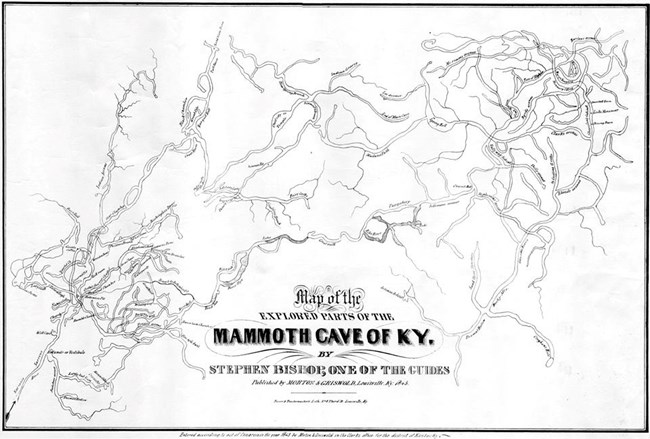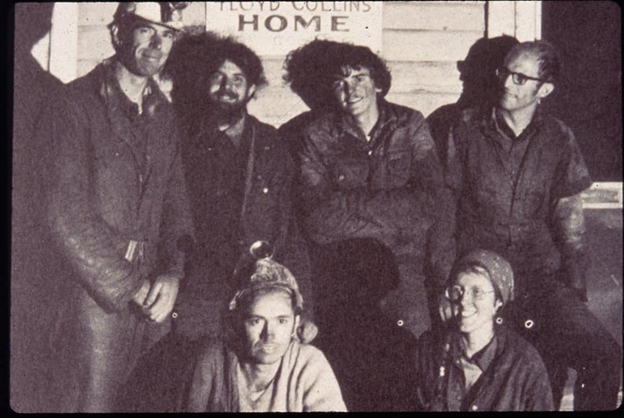Last updated: September 7, 2022
Article
Exploring the World's Longest Known Cave
Mammoth Cave is currently mapped and explored at 426 miles (686 km), but that is just what has been discovered to date. The Cave Research Foundation (CRF), an official park partner, has mapped and explored Mammoth Cave since the late 1950s. Their exploration efforts have made substantial advancements in the length and knowledge of the cave, but CRF was not the first to explore the winding passages. Mammoth Cave wouldn’t be the longest known cave in the world without the contributions of many adventurous explorers who dared to discover what lay beyond the light.

NPS Photo
Early Explorers
For thousands of years humans have been entering Mammoth Cave. Prehistoric American Indians were the first to enter the cave around 5,000 years ago and explored over 19 miles of cave passage within what is now Mammoth Cave National Park.
In modern history, Stephen Bishop, an enslaved Mammoth Cave guide, extended Mammoth Cave’s known length and made one of the first maps in the 1840s. He, along with the other guides of his era discovered new passageways to take the many tourists who flocked to visit the dark labyrinth of Mammoth Cave.
Almost 100 years later in the 1930’s, two well known Mammoth Cave guide families by the names of Hanson and Hunt, frequently explored “lost” passageways in their free time and added to the cave’s known mileage. In 1938 Pete Hanson, Carl Hanson, Leo Hunt, and Claude Hunt after hours of exploration found an area they named New Discovery. It contained huge trunk passage ways and places covered in large, yet very delicate, gypsum deposits.
And it wasn’t just Mammoth Cave being explored. Across the valley, Floyd Collins, an avid caver, discovered Crystal Cave in 1917 and actively explored many other caves within the Mammoth Cave area.
Though none of these pioneering cave explorers knew it, they were, in fact, exploring the longest known cave system in the world. It wasn’t until many years later that a famous connection occurred on September 9th, 1972 between two cave systems that changed Mammoth Cave’s history and the world of caving forever.
Two Cave Systems
There were three significant cave connections on the Flint Ridge side of the valley that took place between the 1950s and 60s that would pave the road for the famous 1972 connection. The first was in 1955 when Crystal Cave was connected with Unknown Cave. Five years later, in 1960, Salts Cave was connected to Colossal Cave and in 1961 Salts Cave was connected to Unknown Cave. This meant that all four caves (Crystal, Unknown, Colossal, and Salts) were connected and identified as one: the Flint Ridge Cave system.
Before 1972, the Flint Ridge Cave system was the longest known cave in the world with 86.5 miles (139.2 km) of mapped passageways and the Mammoth Cave System, located one ridge over, was mapped at 57.9 miles (93.2 km) long. The next task for explorers was to connect the two. Many trips came and went in the Flint Ridge system with nothing new being found. During a trip on September 2, 1972, though, a group in the Flint Ridge system found signatures of Leo Hunt and Pete Hanson in a passage that is now known as Hanson’s Lost River. This gave the cavers indication they were indeed connected to the Mammoth Cave system, but they couldn’t be sure.

Back Row (L-R): John Wilcox, Richard Zoph, Steve Wells, and Cleve Pinnix. Bottom Row (L-R):Gary Eller and Pat Crowther.
NPS Photo
The Connection that Changed Everything
The September 2nd trip was supposed to be the last one scheduled for the year, but an all-time low water table on September 9th would mean that Hanson’s Lost River would not be filled with water. The explorers decided to take advantage of this opportunity. On the morning of September 9, 1972, a team of six people went in the Austin Entrance on the Flint Ridge side of the valley and traveled through the cave for 12 hours before they reached Hanson’s Lost River where they assumed the connection point would to be.
After 12 hours of caving, the group was tired, muddy, and slightly wet. The leader of the group, John Wilcox, continued through Hanson’s Lost River by himself to save the others their energy in case the passage siphoned off, but to his amazement, it did the exact opposite.
The passageway opened into a large room which Wilcox scanned with the small light mounted on his caving helmet. His light shone on a surprising discovery, and Wilcox yelled back to the group, “I see a tourist trail!’ As they all came rushing through the passage to join Wilcox, they realized, at that moment, they were in Mammoth Cave and they had climbed the Mt. Everest of the caving world.
That night the Flint and Mammoth Cave system were connected for a total of 144.4 miles (232.39 km) long. The Flint Mammoth Cave system became the new longest known cave in the world, but would later become known as the Mammoth Cave system due to Mammoth Cave being the more popular name. With continued exploration, Mammoth Cave has remained at the top of the list ever since this moment in 1972.
The exact length of Mammoth Cave is still unknown, but because of an obsession by people like the group in 1972 or the early explorers who wanted to know what could be found beyond every crack and crevice, the cave system continues to grow today.
Learn more by watching a short video on the 1972 connection and hear from the 1972 team of explorers about their historic discovery.
